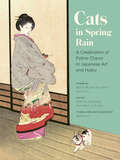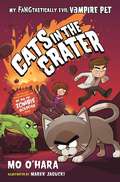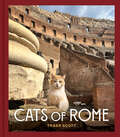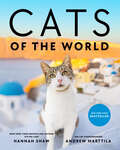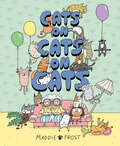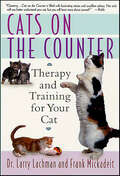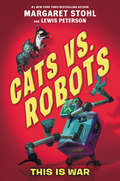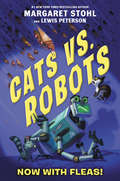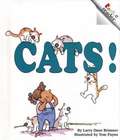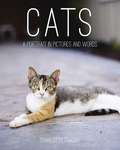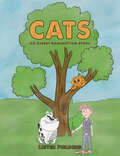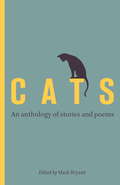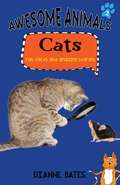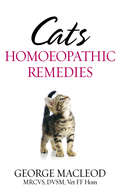- Table View
- List View
Cats in Spring Rain: A Celebration of Feline Charm in Japanese Art and Haiku
by Aya KuschThis delightful little book pays homage to the cat through artfully curated Japanese poetry and prints.No one captures the graces and idiosyncrasies of cats quite like the painters, printmakers, and haiku masters of Japan. From the Edo to the Showa period, many artists turned their gaze toward an unlikely subject: their small feline companions. Closely observed portraits in words ad ink elevate the everyday adventures of cats: taking a nap on a Buddha statue's lap, daintily eating a rice ball, courting the neighbor's cat. This curated collection of poems, prints, and paintings will leave you inspired to cultivate the serenity and wonder embodied by these creators—and by the cats themselves. Presented as a sweet, jacketed paperback with thoughtful design touches, this volume includes each poem in both English and Japanese.THE ORIGINAL CAT LOVERS: Centuries before the emergence of cat memes and cat cafes, Japanese artists and writers perfected the practice of feline reverence. Cats played pivotal roles in folklore; they were the protectors of scriptures and symbols of good luck and wealth. They also proved to be a wonderful source of creative inspiration. This little compendium showcases Japan's rich cultural heritage.UNIQUE GIFT: Surprise your cat-loving friends and family with this unusual twist on the cat-themed gift.PERFECT FOR POETRY LOVERS: Whether they came to poetry through the works of Instagram poets, or have been reading the classics for decades, any lover of verse will enjoy this thoughtfully curated collection. The writers featured include Bashō, Chiyo-ni, Issa, Shiki, and more—all icons of the haiku form.ENCHANTING ART: Hokusai, Hiroshige, Yoshitoshi, and more: These artists masterfully captured the personalities of cats and their humans. These images, with their delicate lines and soothing colors, have endured through time to bring us quiet joy.Perfect for:• Cat lovers• Poets and poetry readers• Artists and art lovers• Anyone who appreciates Japan's arts and culture
Cats in the Belfry
by Doreen ToveyRediscover this lovable classic in a delightful new illustrated edition of these warm and witty cat tales, first published over forty years ago. Animal lovers Doreen Tovey and her husband Charles acquire their first Siamese kitten to rid themselves of an invasion of mice, although they worry about the cat attacking the birds. But Sugieh is not just any cat. She's an iron hand in a delicate, blue-pointed glove; an actress, a prima donna, an empress of cats, and she quickly establishes herself as queen of the house. Thus enslaved, the Toveys try to minimize the chaos Sugieh causes on a daily basis: chewing up telegrams, tearing holes into anything made out of wool, and screaming like a banshee. However things get more complicated once Sugieh decides she's ready to become the perfect mother. Then she and her adorable kittens devote themselves to tightening their grip on the household. You'll share Doreen Tovey's enthusiasm for animals and her infectious feeling of joy toward all the creatures in her household. Surrounded by the friendly astonishment of the village characters who populate the neighborhood, like Father Adams, the local rector--the Tovey household is here again with it's deep though sorely tried love of animals and its splendid portrayal of the country scene. The affectionate illustrations by artist Dan Brown, who specializes in animals, truly capture the essence of the Siamese, helping to bring both the stories and characters to life.
Cats in the Castle (Animal Ark Hauntings #9)
by Ben M. BaglioMandy Hope wins a weekend in a secluded castle. Then they notice the odd cat themed decor, but the owner Mrs. Hapgood insists there are no cats around. Will Mandy and James be able to get to the truth of it all?
Cats in the Crater: My FANGtastically Evil Vampire Pet (My FANGtastically Evil Vampire Pet #3)
by Mo O'HaraIn Cats in the Crater: My FANGtastically Evil Vampire Pet, the third in the spin-off series to Mo O'Hara's New York Times bestselling My Big Fat Zombie Goldfish chapter books, an aspiring evil scientist and his mostly evil (and totally forbidden) vampire kitten must face a trap-filled Volcanic Lair at Evil Scientist Summer Camp.Welcome back to Camp Mwhaaa-haa-ha-a-watha!My epic summer at Evil Scientist Summer Camp hasn't gone quite like I planned, but THIS week I will DEFINITELY be Evil Emperor of the Camp. I've been stocking up on evil inventions and Fang's been sharpening her claws. We're ready for anything!Okay, so maybe I wasn't really prepared to find out that Geeky Girl's grandmother is actually Madame Mako, inventor of the original volcano lair, and ruler of the most famous evil empire ever . . . but, this is going to be GREAT. Geeky Girl can inherit her grandmother's empire, and I'll come in as Head Partner, and help teach her the best way to be an evil ruler—with an epically evil crown!Let our Epic Evil Empire begin!Signed,The Great and Powerful MarkFeaturing illustrations by Marek Jagucki
Cats of 1986: The Book
by Eleni N. GageA celebration of cats and the totally awesome '80s, this book takes readers through the playful lives of furry felines living in 1986. Filled with colorful snapshots of cats as they go to school, hang at the mall, veg out at home, and do their thing, this hilarious volume captures the essence of the '80s—and takes it to the max with cats! Featuring the greatest trends of that decade—from fashion fads (neon, big hair, and shoulder pads) to pop-culture highlights (Jane Fonda, WHAM!, and more)—this paw-sitively irresistible mash-up is sure to delight those who love cats and all things '80s. Radicat!
Cats of Rome
by Traer ScottFrom the award-winning author of Finding Home and Rescue Cats: a dazzling collection of photographs of cats throughout the iconic city of Rome.Whether you are a cat lover, armchair traveler, or photography buff, Traer Scott’s Cats of Rome will entice you into this ancient city that is home to more than 300,000 cats. Of these, at least one-third are thought to be feral. As Roman cats are protected by law, they have the right to live where they choose in architectural ruins, parks, and neighborhoods throughout the city.In seventy-five brilliant color photographs, Rome’s feline denizens are shown as they live naturally among stunning, classical backdrops, with visual whispers of the gattaras—the often nameless and plentiful women of Rome who volunteer to care for the feral colonies. These beautiful cats are safe, cared for, and magnificent, and this keepsake volume is perfect for anyone who has visited Rome or dreams of doing so.CELEBRATED PHOTOGRAPHER: Traer Scott, award-winning photographer and animal welfare activist, turned her lens on the cats of Rome as she explored the Eternal City and sought out evidence of its estimated four thousand feral cat colonies. Through her practiced lens, these majestic felines and their breathtaking surroundings—from the Colosseum to lush cemeteries to the ruins of Porta Magica—create an irresistible travelogue for cat lovers and travel enthusiasts alike. Scott’s bestselling animal photography books include Forever Home, Radiant, and Shelter Dogs.CAT COFFEE TABLE BOOK: Several children’s books feature the wondrous cats of Rome, but this is the first photography book to showcase the beloved cat sanctuaries of this historic and uniquely beautiful European city.ITALIAN HISTORY: Each chapter showcases one of Rome’s vibrant cat colonies, with introductory text about the location, a brief bit of history, and an overview of the cat population’s roots within it. From ancient to modern Rome, this artful book offers a visual journey through a mesmerizing place.Perfect for:Cat lovers and collectors of cat photographyTravelers and armchair travelersFans of Italian culture, history, and architectureReaders who enjoy nature, animal, and travel coffee table books
Cats of the World
by Hannah Shaw Andrew MarttilaAn Instant New York Times Bestseller. Hannah“Kitten Lady” Shaw and professional cat photographer Andrew Marttila journey to thirty countries to bring you hundreds of photos and stories of cats from every corner of the world. Wife and husband team Hannah Shaw and Andrew Marttila have made cats their lives' work: they rescue and rehabilitate neonatal kittens, educate the public on cat and kitten care, and capture our feline friends' unique personalities through writing and photography. Now, in the project of their dreams, they've taken their passion for cats global. In Cats of the World, Shaw and Marttila travel across thirty countries to explore feline welfare and cat culture around the globe, documenting their travels with stunning photos and stories from each location. Journey to England's charming pubs and candle-lit cathedrals, Chile&’s vibrant produce markets and colorful hillsides, Türkiye&’s spice bazaars and ancient ruins, South Africa's bustling streets and lush mountains, and so many places in between with Shaw and Marttila as they learn from cats—and the people who love them most—that compassion is truly a universal language. <br><b>New York Times Bestseller</b></br>
Cats on Catnip
by Andrew MarttilaA humorous collection of dozens of photos of funny and adorable cats as they play with, roll in, and chow down their favorite snack of choice -- catnip. Cats love catnip. Whether it's eating it, playing with it, or rolling around in it, catnip turns our domestic feline friends into hilarious balls of activity. Carefree and unconstrained, they are free to be silly, exceptionally playful, and downright gnarly. Professional pet photographer and self-confessed crazy cat man Andrew Marttila (the photographer behind Shop Cats of New York) captures a range of the cats' silly and expressive personalities as they react to their catnip trip. Delightful, elegant Fluffy transforms into a hell-bent renegade. Shy, reserved Mittens becomes a free-loving acrobat. In the blink of an eye, a cat's expression transforms from bored to inquisitive to playful to curious to bizarre . . . to utterly unhinged. A fun and delightful look at our furry companions, this gift book is perfect for every cat lover.
Cats on Catnip: A Grow-your-own Catnip Kit
by Andrew MarttilaAndrew Marttila has been a professional animal photographer for the past five years and most of that time has been dedicated to photographing cats exclusively. With his set-up he's able to capture wonderful split-second images of'cat's most abandoned expressions as they enjoy every cats favourite treat, catnip. Andrew rescues and raises orphan kittens with his partner Hannah Shaw (the internet's famous Kitten Lady), and many of the models were hand-raised by Andrew and Hannah from newborns. Catnip, or Nepeta cataria, grows wild in many parts of the world and is extremely easy to grow at home in most climates. It's part of the mint family and contained within the bulbs, stems, and leaves is an oil called nepetalactone. Once eaten, rolled on, or crushed, the oil binds to the cat's nasal receptors and stimulates a response that affects a number of areas in the brain, including the hypothalamus and amygdala, two regions that are key in regulating emotional and behavioral responses to stimuli. This produces a mild euphoric effect and typically lasts about ten to twenty minutes.Catnip is non-addictive and harmless and provides a temporary respite from your cat's gruelling workload of napping all day.
Cats on Cats on Cats
by Maddie FrostA hiss-terical new picture book from powerhouse creator, Maddie Frost that answers the question: how many cats is too many cats?Every weekend Bea goes to visit her grandmother, and Granny treats her to an afternoon of special things, like going to the movies and shopping. Bea is always sad to leave at the end of the weekend because she worries that Granny will be lonely without her.So Bea comes up with a plan to keep Granny company during the week: a cat! Granny is a little confused because she doesn't remember mentioning that she likes cats, so she asummes that Bea must want a cat around when she visits. And in doting grandmother fashion, &“what&’s better than one cat?&” she reasons—more cats!Suddenly Granny's apartment is overcrowded, smelly, and worst of all--the cats tear apart Bea's stuffed animal. It's a pure CATastrophe and Bea has got to put a stop to it to get her special weekends with Granny back.Maddie Frost's new picture book is a hilarious set of miscommunications but will remind readers that good old-fashioned quality time is the purrfect way to show your loved ones that they're more than enough.
Cats on Instagram
by @cats_of_instagramFrom the popular Instagram profile comes this collection of adorable cat photos to warm the hearts of cat lovers everywhere.Cat lovers, rejoice! This irresistible book compiles more than four hundred photos from the hugely popular Instagram profile @cats_of_instagram into a keepsake treasure. Playful categories including “bowties,” “surprise!,” and “happy cats” showcase all the charm and delightful quirks of the wide world of cats. This is an ebook that will have feline fans smiling in recognition, surprise, and appreciation.
Cats on the Counter: Therapy and Training for Your Cat
by Larry Lachman Frank MickadeitCats are wonderful companions, but when they misbehave it can be challenging, if not outright difficult, to successfully treat the behavior problem in order to restore feline harmony to the home once again. In Cats on the Counter Dr. Larry Lachman uses his unique approaches, borrowed from human therapy, to analyze what makes kitty tick, and what happens when his behavior gets out of control. Using a case-by-case format, behaviorist Lachman and journalist Frank Mickadeit deal with common problems such as clawing furniture, refusing to use the litterbox or spray marking in the house, fussy eating, and fighting with other cats. Cats on the Counter is filled with fascinating stories, excellent advice, and empathy for both misbehaving pets and their long-suffering people. Other topics include:The Freudian Feline and Family Therapy: cat personality and structural family systems therapyThe Jekyll & Hyde Kitty: cat aggressionKitty Prozac: preserving your cat's mental healthAilurophobia: the fear of cats and how to treat itKidproofing your Cat: teaching your children how to care for your catLassie Meets Morris/Morris Meets Simba: introducing dogs to cats and cats to catsThe Final Feline Moment: pet loss, grief and how to say goodbye"Holy Cats Batman!": Kitty ESP, catnip treats, and afterthoughts
Cats vs Dogs: Misbehaving mammals, intellectual insects, flatulent fish and the great pet showdown
by New ScientistInformative, surprising and hilarious, New Scientist tackles questions about the animal kingdom from readers in the magazine's popular 'Last Word' column. This book brings together the best of the bunch:Why do millipedes have so many legs? Will we ever speak dolphin?Do geese always fly in a V formation?And, at long last, a scientific verdict on the ultimate question: cats or dogs?
Cats vs. Dogs (National Geographic Kids Readers)
by Elizabeth CarneyChocolate or vanilla? Creamy peanut butter or crunchy? Cats or dogs? On some matters in life, every kid must take a stance. Ever since the first youngster in history had a pet, cats vs. dogs has been a hotly debated issue at recesses and lunch tables worldwide. Which one's better? Smarter? This reader presents the facts in fun and informative fashion. Kids will love the stimulating Level 3 text as they decide the answer to this question for themselves.National Geographic supports K-12 educators with ELA Common Core Resources.Visit www.natgeoed.org/commoncore for more information.
Cats vs. Robots #1: This Is War
by Margaret Stohl Kay Peterson Lewis Peterson#1 New York Times bestselling author Margaret Stohl and Lewis Peterson’s hilarious middle grade debut has it all: robot overlords, secret feline agents, and earthling humans who are in for a real catastrophe.With examples of why coding is fun and other STEM applications cleverly woven into this fun and thoughtful story about looking beyond binary terms, this is the perfect novel for fans of House of Robots and The Tapper Twins. The Robot Federation and the Feline Empire have been at war for eons. And now that fight is coming to a tiny primitive planetoid…Earth. The mission for both cats and robots: retrieve the Singularity Chip. With it, cats can live past their nine lives, and robots are granted eternal battery life. Meanwhile, twin siblings Max and Min Wengrod are as different as can be. Min always gets good grades, and she loves to read and build robots. Max hates school, and prefers to play games and spend time online with friends.When Max rescues two kittens and is determined to keep them, Min is horrified that these furballs could ruin her chances at the Battle of the Bots competition. But with hidden forces at play in their own house, and the larger war between cats and robots fast approaching, will the twins be able to put aside their differences before they get caught in the crossfire?
Cats vs. Robots #2: Now with Fleas!
by Margaret Stohl Lewis Peterson#1 New York Times bestselling author Margaret Stohl and Lewis Peterson are back for book two in the hilarious middle grade series!Book one of the Cats vs. Robots series was praised for its "mix of tech and kitties, STEM and heart" by the Bulletin of the Center for Children's Books.In book two, the intergalactic war between the Feline Empire and Robot Federation has escalated to the brink of war. Cats and robots are preparing to converge on Earth and battle it out for the Infinity Engine. And the inventors and safekeepers of that powerful weapon? The Wengrod family. Max, Min, their parents, and cousin Javi, all know the stakes are higher than ever as the fate of their planet rests on their shoulders.The family creates an elite swarm of robotic fleas to attempt infiltrating both sides and halt attacks, but will peaceful persistence be enough? Will they ever rescue their friend Obi? Will Huggs and his sidekick, Vice President Parker P. Pants (VP P.P. Pants), with all their power and influence, prevail in the end? Margaret Stohl and Lewis Peterson bring hilarity, heart, and the case for tolerance in the second book of the Cats vs. Robots series!
Cats: A Miscellany
by Anna-Maria EspsäterThis pocket-sized miscellany, packed with fascinating facts, heart-warming stories and inspiring quotes about cats, is perfect for anyone who knows the incomparable joy of hearing the soothing purr of a feline companion.
Cats: A Portrait in Pictures and Words
by Charlotte FraserEvery cat knows how to charm. Their alluring countenance and flawless prowess will put a smile on any feline lover's face. This stunning photographic collection of the cutest and most exquisite cats, complemented with a sprinkling of feline-inspired quotes and poems, is guaranteed to captivate and enchant anybody who has ever known the comforts of living with a cat.
Cats: An Albert Ramsbottom Story
by Lister FieldingBeing a Lancastrian, I enjoyed Stanley Holloway’s Albert and the Lion as a child and so resolved to attempt monologues of my own, choosing the main character, Albert Ramsbottom in tribute to that earlier story. My first tale, A Visit to the Zoo is now being followed by Cats in which Albert retains all his ability to get in and out of trouble. His sense of mischief is not always appreciated by his companion, Lucky the bulldog. As a boy, I too owned a bulldog, although naturally, I allowed my mum to perform the more mundane tasks relating to the animal’s welfare such as feeding and cleaning up any little mishaps. I have witnessed my eldest daughter, Sarah, perform the same services to dogs with ownership being claimed by her own sons, who despite their careless attitudes towards their pet’s daily needs, have been rewarded with that same unquestioning loyalty and affection. I do hope you enjoy the book and that it makes you smile when reading it to your young audience or indeed to yourself.
Cats: An anthology of stories and poems
by Dr Mark BryantFrom beautiful lyrics to madcap waggery, from the prime suspect in a partridge killing in ancient Greece to the medieval monk's cat Pangur Bán and encompassing odes, fables, stories, limericks, songs, nursery rhymes and more, Mark Bryant has compiled a wonderfully evocative collection of writing of all kinds on cats by those who love them. There are poems from Chaucer, Baudelaire, Emily Dickinson, Thomas Hardy, Christina Rossetti, Shelley and Wordsworth; humorous pieces by Lewis Carroll, Ambrose Bierce, Edward Lear and Jerome K. Jerome; and other delights from writers such as Edgar Allan Poe, Saki and Mark Twain. From ancient Egypt to the recent past, covering every genre, from humour and fantasy to romance and horror, and drawn from every part of the world, these stories, poems and excerpts from essays, letters, diaries and journals provide a collection to delight any cat-lover.
Cats: An anthology of stories and poems
by Mark BryantFrom beautiful lyrics to madcap waggery, from the prime suspect in a partridge killing in ancient Greece to the medieval monk's cat Pangur Bán and encompassing odes, fables, stories, limericks, songs, nursery rhymes and more, Mark Bryant has compiled a wonderfully evocative collection of writing of all kinds on cats by those who love them. There are poems from Chaucer, Baudelaire, Emily Dickinson, Thomas Hardy, Christina Rossetti, Shelley and Wordsworth; humorous pieces by Lewis Carroll, Ambrose Bierce, Edward Lear and Jerome K. Jerome; and other delights from writers such as Edgar Allan Poe, Saki and Mark Twain. From ancient Egypt to the recent past, covering every genre, from humour and fantasy to romance and horror, and drawn from every part of the world, these stories, poems and excerpts from essays, letters, diaries and journals provide a collection to delight any cat-lover.
Cats: Fun Facts and Amazing Stories (Awesome Animals #2)
by Dianne BatesCats are more than just cute and cuddly pets. They are playful, clever, mysterious and totally awesome! Packed full of incredible true stories, fascinating facts and lots of fun stuff, this books shows just how remarkable our feline friends really are. From stories about cat adventurers, famous cats and spoilt cats to bizarre facts and wacky cat jokes, this book will entertain and make you smile. This gorgeous book also features lots of beautiful illustrations and images of the adorable cats and kittens from Little Legs Pet Rescue
Cats: Homoeopathic Remedies
by George MacleodThis book is written to satisfy the needs of the increasing numbers of cat lovers who are interested in alternative methods to treat the illnesses to which their pets may fall prey. This comprehensive guide introduces the principles of homoeopathy and the nature of homoeopathic remedies, explaining how remedies can be prepared and administered. There are informative sections on treating the different feline bodily systems and the specific diseases that cats may suffer from. There is also advice on treating common feline ailments such as parasites, wounds and injuries.
